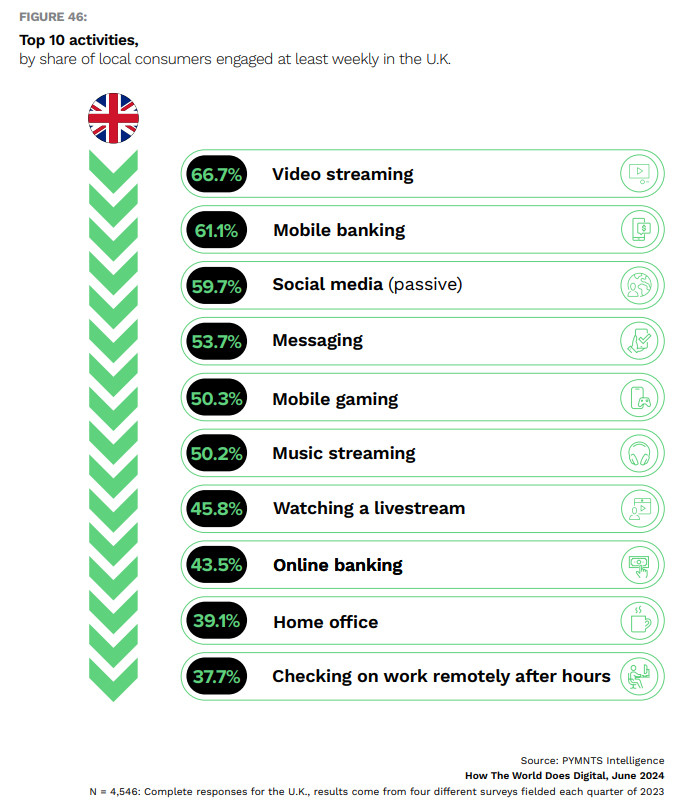
Driven by widespread access to high-speed broadband and advanced mobile networks, the U.K. boasts a population deeply engaged with the digital world. From video streaming taking the top spot to online banking, mobile gaming, messaging and social media following closely behind, the U.K. thrives in a connected landscape.
As a result of the its digital performance in PYMNTS Intelligence’s “How the World Does Digital” report, the U.K. ranks sixth of 11 surveyed countries, including European neighbors Italy, Spain, France, Germany and the Netherlands.
The report sheds important light on the digital habits of a massive 817 million consumers across these countries. It paints a fascinating picture of digital engagement, analyzing consumer behavior in 11 key areas like banking, shopping, communication and entertainment.
As the report shows, nearly everyone in the U.K. has access to high-speed internet (95.9% in 2022) and advanced mobile networks (almost everyone with 4G and 68% with 5G access in 2022). Smartphone ownership is nearly universal among adults, while most (95.5%) U.K. adults use debit cards, and credit card use was at 62.1%.
 More than half of U.K. residents engage in video streaming, mobile banking, social media (passively), messaging, mobile gaming and music streaming at least weekly.
More than half of U.K. residents engage in video streaming, mobile banking, social media (passively), messaging, mobile gaming and music streaming at least weekly.
Mirroring the weekly engagement data, video streaming (16.6 days) leads the way for the highest average number of activity days per month. Passive social media (15.3 days), messaging (13.6 days), mobile banking (13.6 days), and mobile gaming (12.9 days) round out the top five monthly activities. The data underscores the diverse ways U.K. residents integrate digital tools into their daily lives, both for entertainment and practical needs like work and finance.
Gen Z leads the pack with the highest digital engagement (427 activity days), followed by millennials (358 days), Gen X (247 days), and baby boomers (146 days). High-income earners exhibit the most digital activity (295 days) compared to middle-income (275 days) and low-income earners (252 days).
A whopping 40% of U.K. consumers qualify as “digital enthusiasts,” surpassing global counterparts like the U.S. (36%) and Mexico (33%). This translates to a strong preference for digitally enhanced shopping experiences. Despite consumer enthusiasm, a concerning disconnect remains between their digital shopping expectations and what retailers offer, according to PYMNTS research.
A study by PYMNTS Intelligence, in collaboration with Visa Acceptance Solutions, revealed a significant gap in the U.K. retail landscape. While 92% of online shoppers report satisfaction, a concerning 27% of merchants lack features like flexible payment options and loyalty rewards. Additionally, existing features can be difficult for customers to navigate. This disconnect presents an excellent opportunity for U.K. retailers to bridge the gap and better engage their growing base of digital-first customers.
Despite facing stagnant job growth in the digital sector (only 0.3% last year, the slowest since 2012), the incoming Labour government recognizes the importance of a thriving digital economy. The newly appointed Secretary of State for Science, Innovation, and Technology, Peter Kyle, is committed to unlocking the U.K.’s full digital potential. This includes initiatives like advancing open banking and exploring innovative financial technologies like central bank digital currencies.
The U.K. boasts a solid foundation for digital growth with widespread access to high-speed internet and advanced mobile networks. Capitalizing on this advantage, however, requires retailers to implement features like flexible payment options and user-friendly loyalty programs. At that point, U.K. retailers can position themselves to thrive in the ever-evolving digital landscape.







